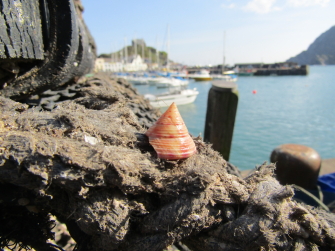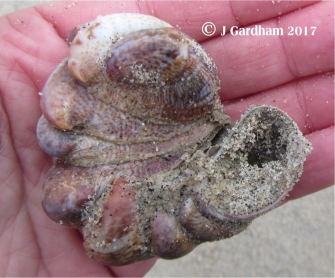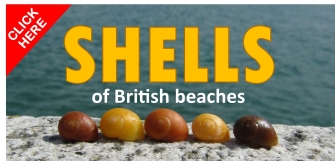

Whorled shells
aka Helical shells
Sea snails, or molluscs, make their own shells to protect their soft bodies. These are often coiled to make a safe place for them to hide their bodies and are quite thick and tough to protect them should they be thrown about by the waves.
While bi-valves (such as scallops and cockles) can pull up the other half of their shell to make sure they are completely protected, whorled shell always have a hole in their shell that they use to stick out their foot and head when they are grazing or travelling. To give them protection from predators and from drying out, they have a trap door (the brown disc shown below) which they can pull tightly closed to keep in moisture and keep out predators.

Have a look down the list or click to fast forward to:
Shells by the sea that aren't really sea shells:
Anyone home?
If you are thinking of picking up a shell to take home,
have a really good look inside to ensure there is no one living there. The trapdoor of a mollusc may only just be visible, or perhaps the claws of a hermit crab. They will be doing their best to hide from you so may not be easy
to spot.
If you find a live sea snail,
pop it into a rockpool where it can wait until the next tide
comes in.
If you find a live dune snail (shown at the foot of this page), it will need to go back into the dunes to keep it safe. Live bivalves are a rarer find on the strandline, but when you do find one, take it to a wet sandy place near the water's edge (only if it is safe for you to do so) where it can bury itself.
Common or edible Whelks
These are quite large shells, about 10cm+ long. They are carnivorous and you can often find the holes they have made in the shells of other sea snails (have a look here) in order to suck out the poor mollusc inside.
The white sea snail, with black spots, inside the whelk shell can be seen in the photo below.
Whelk eggs are often found on the strandline. Photos here.
Whelks are known as buckies in Scotland.
Perhaps this is from an abbrevation of its Latin name, Buccinum undatum.
Netted dog whelk
This sea snail's shell is much smaller than its relative, the whelk above. It is possible to see how the two shells are based on a similar shape however.
Tritia reticulata
Slender Spindle shell
Another member of the true whelk family.
Colus gracilis

Sting Winkle
Another of our carnivorous sea snails. These are rugged little grooved shells, the shells of which sometimes turn up on the strandline.
Despite their name, these aren't related to our winkles and periwinkles which are vegetarian algae-grazers.
The eggs of the sting winkle are also sometimes found on the strandline. Have a look here.
Ocenebra erinaceus
Necklace shell
aka Moon Snail
This is the last in our little exploration of carnivorous molluscs. Again, their shells sometimes get washed up on the strandlines, as do the 'skirts' they grow for holding their eggs (see our page on eggs).
The colour of the necklace shell ranges from yellow, through orange, to brown but always has these distinctive darker 'ticks' on its whorl.
Euspira catena

Pheasant shell
These tiny shells - here they are on a five pence piece - are remarkably resilient as they often turn up whole on the beach, having been washed up from where they feed out at sea on red kelp.
Tricolia pullus canarica
Top shells
The painted (or flat) topshell (left) (gibbula umbilcalis) is glorious in pink or purple with silver stripes. The mother of pearl in this shell was prized by the Victorians as buttons. Below right is the conical Painted Top shell (Calliostoma zizyphinum); middle is the grey top shell (Gibbula cineraria); right is the thick (or toothed) topshell (Osilinus lineata. Formerly Monodonta lineata)

The video clip shows the snail's long foot, antennae and small head revealed from under its trap door.
Slipper Limpet
The slipper limpet was accidentally introduced from North America (probably coming in stuck to ships) but is now common in southern England where it is thought to be impacting negatively on our native molluscs. There are strict regulations on using slippers as bait to try to halt its spread to the rest of England.
The slipper limpet is not a relative of our common limpet.

The slipper limpet is named after slipper boats and not the comfy footwear.
Slipper limpets have become common on the south coast of England.

We've been sent this fantastic photo by Jane who saw lots of 'clumps' of live slipper limpets on the beach in Bournemouth. They do tend to stick firmly together like this with the males, the smaller ones, on top of the pile.


The wentletrap
I love the name of this shell - it sounds like maybe a mediaeval instrument of torture, or maybe a Nordic dwarf. The shells themselves look as if they are perhaps inside out. In fact. wentletrap means 'spiral staircase' in Dutch and these shells, generally white, are definitely the right way out.
Epitonium sp.
Not all shells that we find on the beach belonged to sea snails, some may have strayed or fallen from the dunes above. These land snails will be air breathing, rather than living underwater like sea snails and generally have shells with far thinner walls making them very fragile. Sea snails have thick shells to protect them from the waves and being thrown about on the rocks.
The sandhill snail and the heath snail
The sand hill snail (about the same sort of size as the garden snail - see below) was inrtoduced from the Mediterranean (initially to St Ives from where it has spread around South West England). Sea holly is its favourite food. The sandhill snail (theba pisana) dwarfs the tiny heath snail (left) (helicella itala) although they both opt to live in sand dunes. Either shell can end up on our beaches.
The Pointed snail
Like the sandhill snail above, this is a very fragile shell. It would not be able to survive the life of a sea snail shell which is much more robust. This little snail, despite its small stature, likes to be high up and so, on the sand dunes, where it likes to make its home, you can find it high up on fence posts or tall grasses.
Cochlicella acuta
Garden snail
This sometimes ends up on beaches where the dunes are in close proximity. They simply stray too far and find themselves in the sand. More commonly, these are the snails you are likely to find in the damp, dark places in your garden.
Cornu aspersum
Round-mouthed snail
(pomatias elegans)
This is a dune snail which appears more like a sea snail than other dune snails as it has a thicker shell. It likes to eat old wood and bury itself in sandy soils but sometimes ends up on sandy beaches.
To see a round-mouthed snail fighting back against a snail-hunter beetle, have a look at this page.

The round-mouthed snail is found in only specific areas in Britain (and only in patches in the south west of England. If you do see it, please either record it on irecord or tell us here. It would help us greatly to understand where it is spreading. Many thanks


























